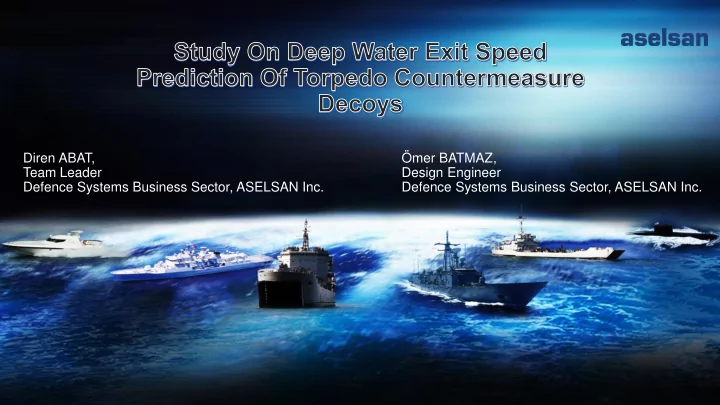

Diren ABAT, Ömer BATMAZ, Team Leader Design Engineer Defence Systems Business Sector, ASELSAN Inc. Defence Systems Business Sector, ASELSAN Inc.
Overview Zargana TM System by ASELSAN Outboard Launchers of Zargana TM Estimation of Minimum Launching Speed Tests & Measurements Exit Speed Analysis Conclusion UDT 2020, Rotterdam 1
Zargana TM System by ASELSAN o Host Platform Data Reception and Processing o Threat Data Reception and Processing o Sonar Data Reception and Processing o Data Processing o Advise on Tactical Evasive Maneuver o Display and Warning o Launcher Control UDT 2020, Rotterdam 2
Outboard Launchers of Zargana TM o Instant reaction (< 5s) o Separate launchers for port and starboard o Interface with decoys/jammers o Automatic programming and powering of decoys/jammers before deployment o High redundancy o Silent launch ( No bubble / gas release to environment) UDT 2020, Rotterdam 3
Outboard Launchers of Zargana TM (cont’d) o Can be configured according to space on submarine Launching Module (LM) Launcher Unit (LU) UDT 2020, Rotterdam 4
Outboard Launchers of Zargana TM (cont’d) o Launching at all operation depths o Gas generators are used inside o Patented design, no gas and bubble release o Decoys/jammers can be programmed just before launch UDT 2020, Rotterdam 5
Estimation of Minimum Launching Speed o Safe separation for an affective soft-kill defense o Safe separation must be possible at, All submarine speeds • • All submarine maneuvers • All operation depths o Multiple numbers of 6DOF simulations are performed UDT 2020, Rotterdam 6
Estimation of Minimum Launching Speed (cont’d) o Simulation involves submarine maneuvers separately; • Heading – Sterning pitch • Roll Also combinations • Turning UDT 2020, Rotterdam 7
Estimation of Minimum Launching Speed (cont’d) o Different launching angles are considered, as well • At horizontal plane • At vertical plane UDT 2020, Rotterdam 8
Estimation of Minimum Launching Speed (cont’d) o Approximately the thousand of simulations were run o Minimum exit speed was determined o Detailed design was proceeded w.r.t. min. decoy exit speed UDT 2020, Rotterdam 9
Tests & Measurements o Launching Unit must be capable of providing min. exit speed to decoy o Tests were performed because of • To specify Launcher Unit geometry (Volume, nozzle profile, etc.) To determine power of gas generators • UDT 2020, Rotterdam 10
Tests & Measurements (cont’d) o How can we measure the exit speed in water? o Magnetic field can be used o Well designed test equipment and prototypes were produced Leakproof Magnetic Coil Electronic Box UDT 2020, Rotterdam 11
Tests & Measurements (cont’d) o Working principle of the test system base on, • Magnetic field of coil is distorted • By means of two magnets on the test decoy • Time step between the two peaks is obtained UDT 2020, Rotterdam 12
Tests & Measurements (cont’d) o Many water tests were performed up to depth of ~200m o Various gas generator types are tried o Avg. exit speeds with each gas generator were recorded Depth (m) Speed (m/s) Gas Generator Configurations 1 23 Configuration 1 Configuration 2 50 23,5 100 17.3 Configuration 3 150 29,2 Configuration 4 180 27 Configuration 5 UDT 2020, Rotterdam 13
Exit Speed Analysis o We need exit speed analysis for more than ~200m depth • Pressure characteristics of gas generators should be modeled • Motion of the decoy during launching should be modeled • Model should be corrected according to sea test results UDT 2020, Rotterdam 14
Exit Speed Analysis (cont’d) o A pressure cylinder with variable inner volume was designed o All specified gas generators were tested at each volume o Pressure vs. Time graphs are obtained o Pressure at the demanded time and volume was put to analysis UDT 2020, Rotterdam 15
Exit Speed Analysis (cont’d) o Launching process of the decoy was modelled as 4 different phases Phase-1: Gas generators are activated. The cap of LU is not opened. Phase-2: Cap is opened. Decoy is moving with ram plate and water inside the LU. UDT 2020, Rotterdam 16
Exit Speed Analysis (cont’d) o Launching process of the decoy was modelled as 4 different phases Phase-3: Ram plate is stagnant. Decoy is leaving from ram plate. Water is filling remaining volume. Phase-4: Decoy is not inside the LU anymore. It gains its exit speed. UDT 2020, Rotterdam 17
Conclusion o For a successful countermeasure, safe separation of decoy must be assured Following steps are followed to define desired exit decoy speed o • All submarine maneuvers were examined with simulation • Sea tests were performed and collected data up to limited depth Mathematical model was constituted and corrected according to sea tests • UDT 2020, Rotterdam 18
Recommend
More recommend